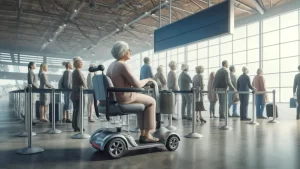Traveling with Mobility Issues: Tips for a Smooth and Memorable Journey

Traveling is one of life’s greatest joys, offering the chance to explore new places, connect with different cultures, and create lasting memories. For those with mobility issues, travel can present unique challenges, but with thoughtful planning and the right mindset, it is entirely possible to have an enjoyable and stress-free journey. Here are practical tips and advice to help make traveling with mobility issues smoother and more fulfilling.

1. Research Accessibility Options
Before booking your trip, invest time in researching destinations that are known for their accessibility. Cities like Amsterdam, Barcelona, and Singapore, for instance, are celebrated for their mobility-friendly infrastructure. Look for information about wheelchair-accessible attractions, transportation systems, and accommodations.
Key Resources:
- Websites like AccessibleGO or Mobility International USA provide insights into accessible travel.
- Reviews from other travelers with mobility challenges can offer valuable firsthand perspectives.

2. Choose Accommodations Wisely
Not all accommodations cater to mobility needs, so it’s important to inquire in advance. Look for hotels or vacation rentals with features like:
- Elevators
- Roll-in showers
- Grab bars in bathrooms
- Wide doorways for wheelchair access
When in doubt, call ahead to confirm details and ensure the facility meets your specific requirements.

3. Plan Transportation in Advance
Getting around in an unfamiliar location can be one of the most challenging aspects of travel. Options to consider include:
- Accessible public transport: Many cities have buses, trams, and trains designed with ramps and designated spaces for wheelchairs.
- Rideshare apps: Apps like Uber and Lyft often offer accessible vehicle options in larger cities.
- Rental services: Companies like MobilityWorks offer accessible vehicles for hire if you plan to drive yourself.
Make sure to research transportation accessibility at your destination and, if possible, book in advance.

4. Pack Smart
Traveling light is ideal, but don’t skimp on essentials. Include:
- Mobility aids: Bring any necessary equipment such as wheelchairs, scooters, or walkers.
- Backup items: Pack spare parts for your mobility aids, like batteries or tires, to avoid disruptions.
- Medical supplies: Keep medications, prescriptions, and medical documents in an easily accessible place.
A compact, well-organized bag with your essentials can save time and reduce stress.

5. Know Your Rights
Many countries have laws in place to protect travelers with disabilities. For example:
- In the United States, the Air Carrier Access Act (ACAA) ensures that airlines cannot discriminate against passengers with disabilities.
- The European Union has similar regulations, guaranteeing assistance at airports and on trains.
Familiarize yourself with the policies and ask for assistance when needed. Most airlines and train companies offer services to help passengers with mobility issues, but these often require advance notice.

6. Prepare for Air Travel
Flying can be one of the trickiest parts of travel for those with mobility issues. Make the experience smoother by:
- Requesting wheelchair assistance for navigating airports.
- Informing the airline about your mobility device and needs.
- Choosing aisle or bulkhead seats for extra space (if available).
- Packing essential items in your carry-on, including medications and documents.
Arriving early ensures you have ample time to get through security and board comfortably.

7. Take Advantage of Accessible Travel Services
Numerous tour operators specialize in creating accessible travel experiences. From guided tours with wheelchair-accessible transportation to cruises designed for individuals with mobility challenges, these services eliminate much of the guesswork and planning.

8. Stay Flexible and Patient
Even with the best planning, unexpected challenges can arise. A delay, a broken elevator, or a detour can be frustrating, but staying patient and adaptable can turn these moments into opportunities for adventure. Traveling with a positive mindset often leads to the most memorable experiences.

9. Build a Support Network
If possible, travel with a companion who can assist when needed. Many destinations also have local organizations or community groups that offer support for travelers with disabilities.

10. Share Your Experiences
Your travels can inspire others with mobility issues to pursue their adventures. Share your tips, reviews, and experiences online to contribute to a growing community of accessible travelers.
Traveling with mobility issues may require extra effort, but the rewards are well worth it. With thoughtful planning, a proactive approach, and a willingness to embrace challenges, you can enjoy all the joys of exploration. Remember, the world is yours to discover—one accessible step at a time.
Safe travels! 🌍✈️




